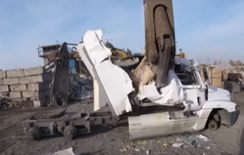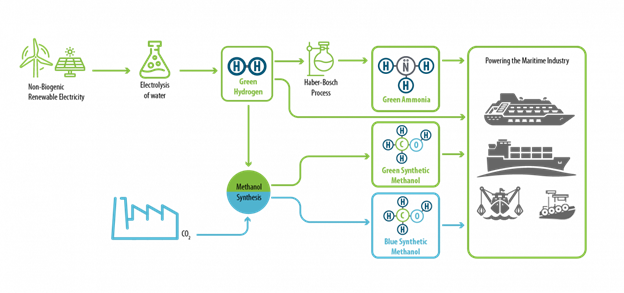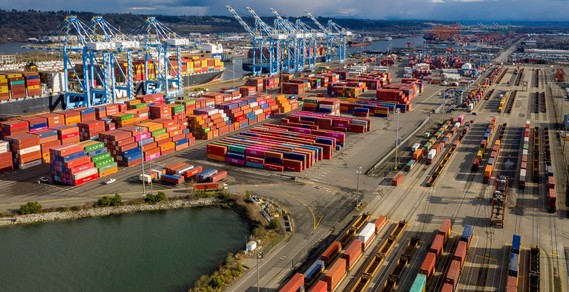|
Welcome to the Ports Clean Air Quarterly, the newsletter for port-related clean air and climate activities. This edition highlights some of the exciting projects happening at the Port of Tacoma, Port of Seattle, and the Northwest Seaport Alliance. Each newsletter will showcase projects and milestones across our gateway, feature a partner or staff member who is focused on environmental sustainability, and highlight upcoming opportunities for community engagement, such as bus tours, commission meetings, or webinars!

Over 4,000 drayage trucks serve our gateway at the Northwest Seaport Alliance (NWSA). Transitioning this entire fleet to zero-emission technologies will be as challenging as it is necessary. That is why the NWSA, with funding support from the Washington State Department of Transportation, is catalyzing the formation of the Puget Sound Zero Emission Collaborative (PS-ZETC): an independently facilitated, multi-stakeholder group that will develop the “Decarbonizing Drayage Roadmap.”
Success in transitioning our drayage fleet to zero emissions will require a high degree of collaboration across many partners, including truck manufacturers, trucking companies, retailers, ports, utilities, fuel providers, charging infrastructure companies, local and state government agencies, near-port communities, and NGOs working on clean air, climate solutions, and environmental justice. The Puget Sound Zero Emissions Collaborative will bring these stakeholders together with the goal of producing a “Decarbonizing Drayage Roadmap”. This roadmap will be a guiding document in identifying the needs, strategies, and challenges on the path to a zero-emission drayage fleet.
This is a long-term strategy for advancing the availability and affordability of zero-emission trucks, development of the necessary charging and fueling infrastructure, and continued support to the trucking community on which the success of our gateway depends. PS-ZETC aims to begin work in early 2023—check future issues of this newsletter for details as they emerge.
|

The Northwest Seaport Alliance has partnered with the Environmental Protection Agency (EPA) to offer another round of scrap bonuses to drivers who still operate a pre-2007 engine truck at NWSA terminals. This program also applies to those who have installed an equivalent emission control device onto their truck for the Clean Truck Program.
Drivers can replace their old truck with a 2015 Model Year (MY) or newer truck and be eligible for up to a $20,000 scrapping bonus.
|
There are 2 levels of scrapping bonus, depending on the age of the replacement truck:
-
Replacement trucks that are 2008-2015 MY are eligible for a $10,000 scrapping bonus
-
Replacement trucks that are 2016 MY or newer are eligible for a $20,000 bonus
The NWSA is offering scrap bonuses using this EPA DERA grant until mid-2023. More information and application forms are available on our website.
 Most oceangoing vessels you see are powered by fossil fuels, most of which are made from petroleum. However, as the climate emergency grows so does the urgency to transition to low and zero-greenhouse gas (GHG) emission energy sources across all sectors of the economy, including maritime industries. Currently, there is not one clear pathway to power oceangoing vessels from cleaner sources of energy, and no zero-emission technology or fuel is commercially available at the scale needed. Ports are taking a leadership role to support the development of low- and zero-emission maritime fuels and plan for the infrastructure that will be needed. Port of Seattle published a blog post that discusses the developing landscape of low- and zero-GHG emission maritime fuels. [Read More]
Over the summer, we broke ground on a project to install shore power infrastructure at our Husky Terminal in the Tacoma Harbor. Shore power is the provision of grid power to ocean-going ships when they are at dock, which allows them to shut down their engines, greatly reducing emissions.
 This will be the second shore power system installed in our Tacoma Harbor and the third in the Tacoma/Seattle Gateway. We expect construction of the Husky Terminal shore power system to be complete in early 2024 and for ships to begin plugging in shortly thereafter.

In 2019, Port of Seattle Commission adopted the Sustainable Evaluation Framework, which directs capital projects and key operational decisions to advance the Port’s sustainability goals. The Terminal 91 Berths 6 and 8 project is an example of the Sustainable Evaluation Framework in action. The project design includes net-zero modular structures with solar panels; electric vehicle charging capability; bicycle storage space; and high-efficiency HVAC equipment, windows, and insulation. The project is also designing unique direct-discharge sewage pump-out infrastructure to serve fishing vessels that will reduce emissions and truck trips to remove sewage waste.
|

Abigail Ames is a Washington Sea Grant Hershman Fellow working with the Air Quality & Sustainable Practices team that serves both the Northwest Seaport Alliance and the Port of Tacoma. The Washington Sea Grant Hershman Fellowship offers a unique educational experience to those who have earned advance training in ocean and coastal policy issues, placing highly qualified individuals with host offices addressing these issues throughout Washington State. Fellows gain first-hand experiences in crafting, analyzing, and implementing natural resource policy as they employ their advanced training to support key environmental programs in Washington.
In her year-long assignment with the Northwest Seaport Alliance, Abigail is excited to lead initiatives to engage and support near-port communities as we work together to phase out seaport-related emissions by 2050. You may find her revising educational content for websites and newsletters (like this one!); collaborating with colleagues across Ports on implementing sustainability programs, and developing strategies for meaningful partnership with community to achieve clean air goals.
Abigail earned her Masters of Marine Affairs in June 2022 from the University of Washington and specializes in climate change adaptation, utilizing her training in marine science and skills in community engagement and science communication to support essential practices (e.g. food security, sustaining ways of life) in a changing landscape. Most recently, she worked with Iñupiaq leaders in Arctic Alaska to address food sovereignty concerns as climate change rapidly alters a landscape once known intimately by hunters. For the Kivalina Volunteer Search and Rescue, Abigail developed a Hazard Assessment and the agency’s first Science and Culture workshop, informed by lived experiences of climate change and analysis of changes to permafrost and fish populations.
Being outside and connecting with the environment is what nourishes Abigail’s soul and is a strong driver of her motivation to engage communities in healing relationships to land, water, and air. As a trained scientific diver she spends as much time as possible under water, fascinated by the rich ecosystems of the Salish Sea. On dry land, she creates things (via knitting, cooking, and so much more), studies Southern Lushootseed, and cares for two cats and countless houseplants.
|
|